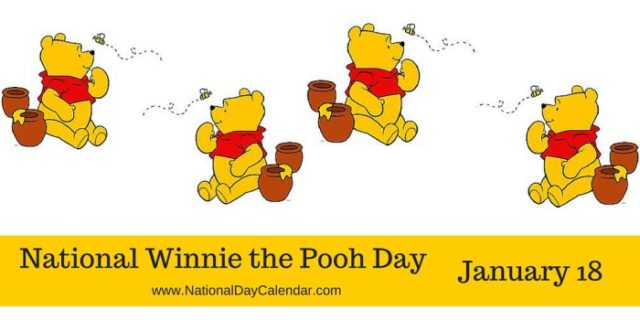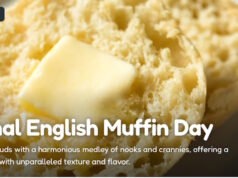
National Winnie the Pooh Day is observed annually on January 18th. Author A.A. Milne brought the adorable, honey-loving bear to life in his stories which also featured his son, Christopher Robin. National Winnie the Pooh Day commemorates Milne’s January 18, 1882, birthday.
Milne’s lovable Pooh Bear, as he was fondly called, is a fictional bear inspired by a black bear named Winnie who lived at the London Zoo during World War I. The author’s son, Christopher Robin, would visit the bear often and named his own teddy bear after her and a swan named Pooh.
This friendship inspired a collection of books starting with Winnie-the-Pooh in 1926. The books were illustrated by E.H. Shepard.
In the 1960s, Disney bought the rights to the Winnie-the-Pooh characters dropping the hyphen from Pooh’s name. The illustrations were a bit different, too.
Milne’s stories have been translated into over 50 languages and are considered classic children’s stories today.
- During World War I, a Canadian soldier named Harry Colebourn made a pet of a black bear cub he bought from a hunter for $20. Named Winnipeg—or “Winnie” for short—the bear became his troop’s mascot and later a resident of the London Zoological Gardens.
- In the 1920s, A.A. Milne began writing collections of stories and poems that became the books When We Were Very Young (which introduced a bear named Edward and a swan named Pooh), The House at Pooh Corner,Now We Are Six, and Winnie-The-Pooh. It was these stories where Christopher Robin’s adored toy animals Pooh, Tigger, Piglet, Eeyore, Kanga, and Roo made their literary debuts. Most of the original toys can be seen on display at the New York Public Library—except for Roo, who went missing in an apple orchard in the 1930s. The likes of Owl and Rabbit were included to loop in some of the fauna that frolicked outside the Milne family home.
- Illustrator E.H. Shepard ambushed Milne for a job of drawing Pooh. Shepard and Milne shared a mutual colleague in English humorist E.V. Lucas, who believed the former would be perfect for the tricky task of bringing Milne’s fantasy world to life in delicate drawings. But Milne was reluctant to hire a political cartoonist, so Shepard took the initiative. As recounted by Milne’s old neighbor, Laurence Irving, Shepard wandered Ashdown Forest, the inspiration for Milne’s mythical woods, and created a portfolio of sketches. Then he turned up unannounced at Milne’s home, where he handed over his portfolio to Milne and won his approval.
- The real Christopher Robin resented his father, and Pooh. Being forever the tender little boy in Hundred Acre Wood didn’t suit Christopher Robin Milne. Like his father before him, he became a writer, but wrote memoirs of his own life, like The Enchanted Places, Beyond the World of Pooh, and The Hollow On The Hill. In these, he asserted, “It seemed to me almost that my father had got where he was by climbing on my infant shoulders, that he had filched from me my good name and left me nothing but empty fame.”
- Scholars and philosophers have been pulling from Pooh for inspiration. American author Benjamin Hoff wrote both The Tao of Pooh and The Te of Piglet to explain principles of the Chinese philosophical school of Taoism. Scholar John Tyerman Williams responded with the long but self-explanatorily titled Pooh and the Philosophies: In Which It Is Shown That All of Western Philosophy Is Merely a Preamble to Winnie-The-Pooh and Pooh and the Psychologists. And English professor and author Frederick Crews penned The Pooh Perplex and Postmodern Pooh, which satirized academic trends in case studies.
Sources:












